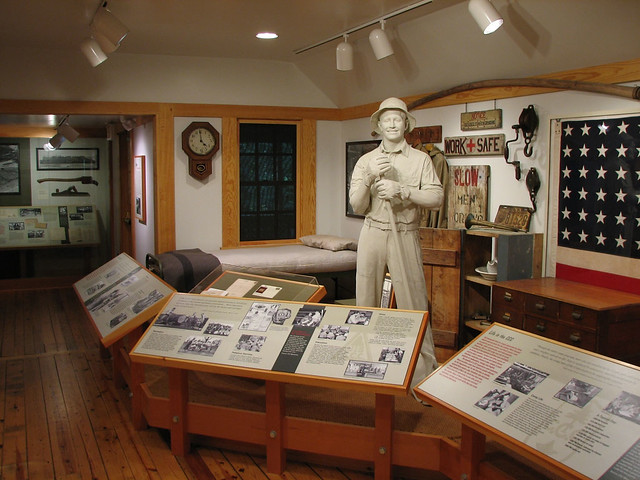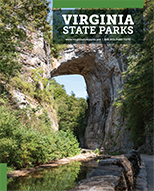Read Our Blogs
15 Campers Needed to Help Preserve History
Shared by Cathy Dieter, as Guest Blogger.
There is an opportunity for 15 campers to join in a project to refurbish some of these CCC-built group cabins to preserve them for new generations at Pocahontas State Park. Dates are October 28 through November 3, 2018.
In exchange for a week of free camping, the volunteers will work together to effect essential repairs to these structures, doing painting, light carpentry and roof repairs.
We need your help to preserve these CCC-built group cabins at Pocahontas State Park
HISTORY
At their worst, the dust clouds blacked out the sun, earning the once fertile plains a new name – the Dust Bowl. Half a continent away, poor farmers in central and western Virginia struggled to make a living on the mountains and hills. The thick forests that once graced their slopes no longer held the soil from eroding the hillsides into the streams below. This was not an accident of weather – an unforeseen drought or too much flooding rain. Instead, decades, if not centuries, of poor farming practices were turning the amber waves of grain into dust and eroding the purple mountain’s majesty.
It was the 1930’s. The economic depression that had begun the decade was wreaking havoc, having thrown millions out of work, shuttering businesses, freezing capital. As a new president taking the oath of office, Franklin Roosevelt was about to address these two big problems facing the nation in his first big initiative. Only a couple of days after taking office, Roosevelt called a meeting to initiate a new program – the Civilian Conservation Corps. His plan was to employ half a million young men to replant, repurpose, and restore the land.
Over the next decade, this new force would restore millions of acres of land to a more sustainable use, recovering its beauty and balance at the same time many were finding the same renewal within their own lives. The men had meaningful work, secure housing, ample food, and an income that was largely used to support their families back home. They would be deployed in national parks and forests, state parks, and even some private lands.
Be sure to visit the CCC Museum at Pocahontas State Park
Within a year of FDR’s inauguration, Congress had authorized the sweeping Federal Emergency Relief Administration. This legislation included a land program with several objectives that included repurposing poor land, restoring its productivity and preventing erosion, while at the same time improving the status of families occupying poverty farms.
In Chesterfield, Virginia, one such property was soon to be transformed into one of the park service’s recreation demonstration areas (RDAs). This was a new idea for turning marginal farm land into a natural recreation area. By locating near a large city, those who might not have access to parks for outdoor activities such as camping, hiking, picnicking and swimming would be able to find it here.
This huge parcel (almost 8000 acres) located just south of Richmond would be transformed into the Swift Creek National Recreation and Demonstration Area. And it was the men of the CCC who would make it happen --damming the creek to create lakes for fishing, swimming and boating; building campgrounds and picnic areas, and building camping cabins, camp kitchens, latrines and dining halls for group camping. The result was overwhelmingly popular. Within a year, the park was hosting 100,000 visitors.
ENTER A STATE PARK
By the time Swift Creek RDA became Pocahontas State Park in 1946, the extent of the facilities available were unique within the Virginia State Park system. No other park was designed with so many spaces to accommodate large groups.
The CCC had delivered on its mission for the park, and its popularity only grew. Eighty years later, two of the group camps within the park are still available with overnight facilities ranging in size from 28 beds to 112 beds. The camps consist of up to four cabin circles (units). Each cabin sleeps from 4 to 8 people. A modern shower house and restroom is located near each unit and has hot showers and flush toilets. Each unit also includes a Lodge building with tables and chairs, an indoor fireplace, and an outdoor grill. A large fire ring is in the center of each unit for outdoor campfires at night.
GROUP CAMP CABINS
A damaged CCC-built group cabin in need of repair at Pocahontas State Park
But the cabins are starting to show their age, and the park is struggling to keep them maintained with less staff and more visitors each year. Many roofs leak and animals have found their way in as well. These historic structures need to be saved.
WE NEED YOUR HELP
After work sessions, the participants will get a chance to relax and enjoy some of the park’s extensive offerings. There are miles of hiking trails and nationally recognized mountain-biking trails. There will also be an opportunity to learn more about the CCC at Pocahontas by touring the park’s CCC museum, housed in one of the original buildings. Other fun activities are being planned such as hay rides and campfires to balance the work time with leisure.
Flexibility to check-out Monday November 5, since the 4th is our Annual Volunteer Appreciation Event with BBQ, fun programs and games for kids and adults alike. We would love you to be there for that.
MORE INFO AND HOW TO APPLY
Working age minimum is 18 – we’re going to need volunteers who can use power tools. Ages 13 and up are welcome to help with an adult age 21 and older (just no power tool usage). Our jobs will include, re-roofing, replacing outside wood walls, pressure washing, replacing wooden flooring, painting and staining over the 6 days of work. The range of projects on the three buildings gives us a lot of flexibility in skill levels. We have 15 sites reserved for you in a loop of our new campground area.
Those interested in this unique opportunity should email Volunteer Coordinator Andi Clinton today to express interest or learn more, as space is limited. This is a chance to become another link in a chain that goes back 80 years.
Deadline to apply is August 31, 2018.
If you have read the article and have a question, please email nancy.heltman@dcr.virginia.gov.


















